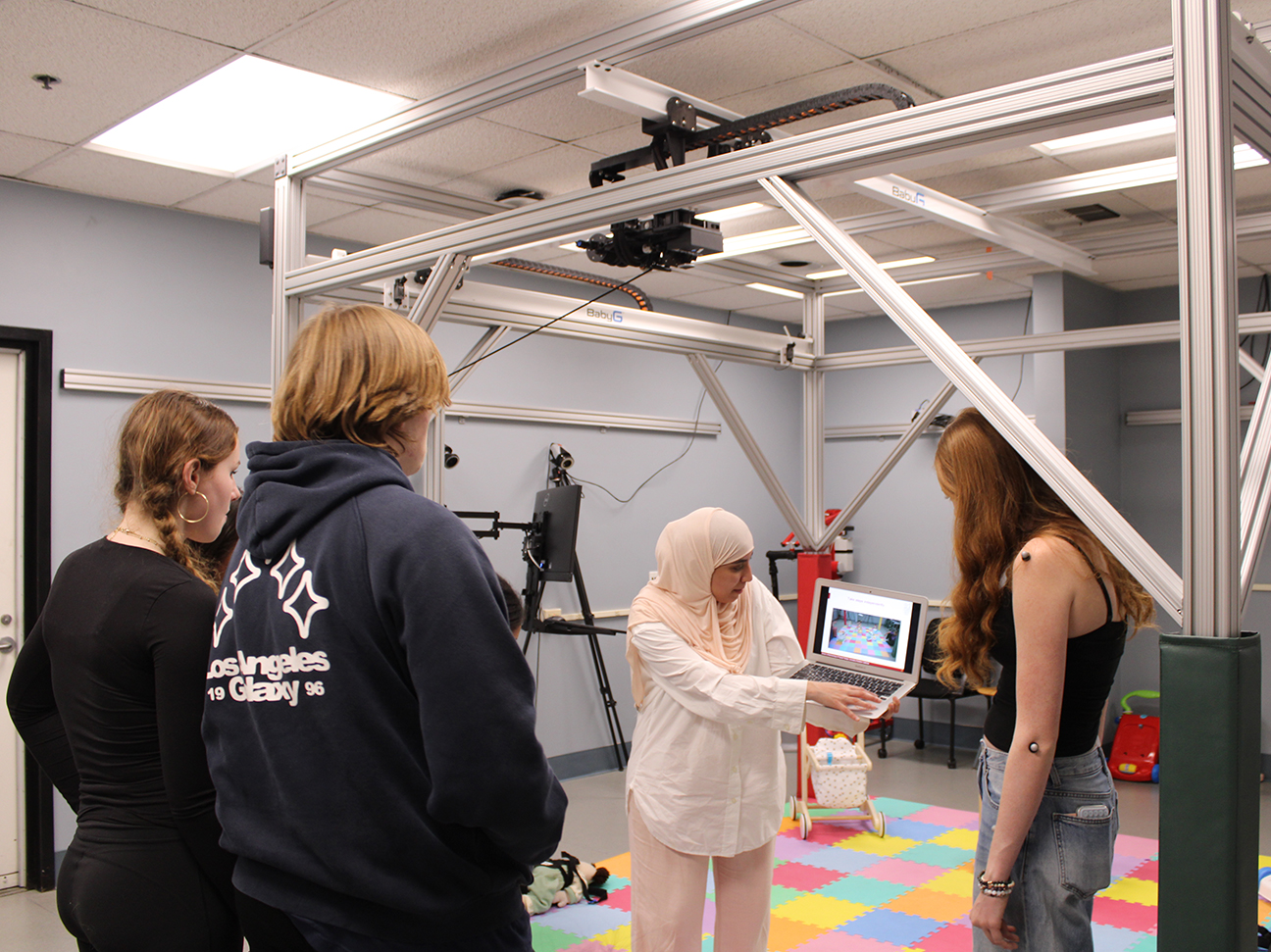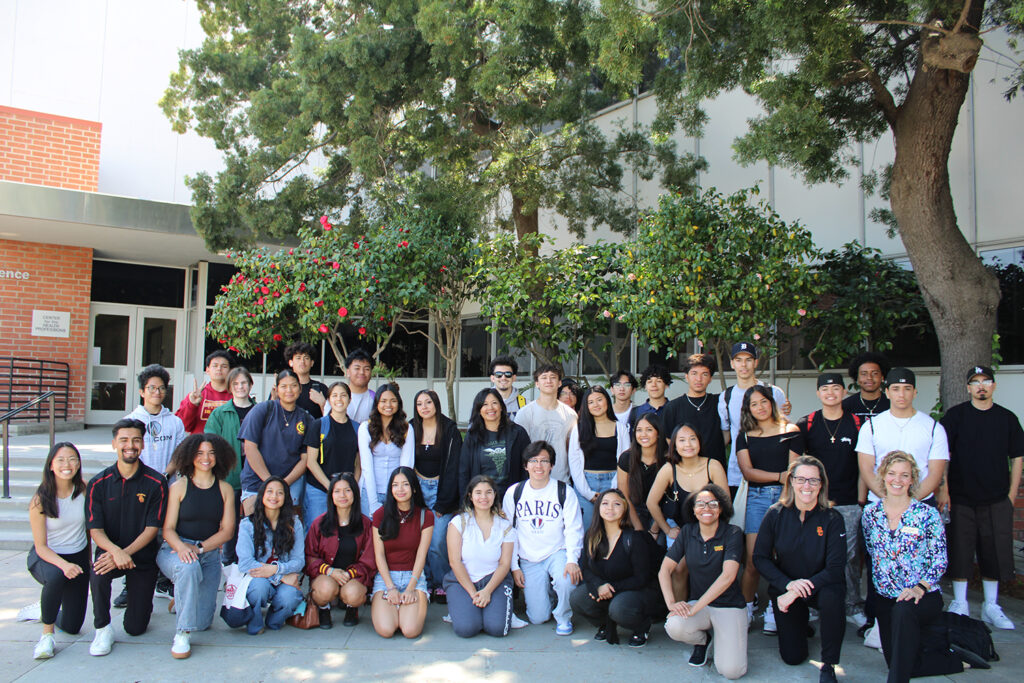04.15.2025
By uscbknpt
USC hosts 60 students from two local high schools for National Biomechanics Day

Celebrated around the globe, National Biomechanics Day aims to introduce high school students to burgeoning fields of study, including biokinesiology and physical therapy.
BY JAMIE WETHERBE MA ’04
WHEN SEARCHING HIGH SCHOOL ELECTIVES, a biomechanics course rarely comes up on the list.
To attract more young talent to the profession, National Biomechanics Day (NBD) was launched in 2016 with the goal of introducing high school students to the burgeoning field. The event has continued to grow, with this year’s international celebration involving 44,000 high schoolers across 46 countries.
A strong NBD supporter from the start, the USC Division of Biokinesiology and Physical Therapy hosted 60 students in early April from two local high schools — the International School of Los Angeles (LILA), a private institution in Burbank, and Eagle Rock High School, a public school part of LAUSD — to commemorate the day.
“Every year, the Division considers different ways to get involved with the community,” says Vanessa Taylor MS ’25, who helped organize the event at USC. “This is a way to combine and share our passions for science, research and education with students who are considering different careers for their future.”
The program — facilitated by 14 USC student volunteers, and three USC faculty and staff volunteers — introduced students to the Division’s labs, research and graduate and doctoral students, while offering demonstrations and hands-on activities.
“These kinds of experiences can be transformative because most people have never seen a research lab, much less a lab that does biomechanics,” Associate Professor James Finley said. “The students are just naturally attracted to [our work], and it’s always quite rewarding to see their excitement.”
Beyond exploring department spaces, this type of exposure allows students to envision themselves in roles they might not otherwise have known existed.
“Many of my students come from communities where access to healthcare careers or academic research opportunities may feel out of reach,” says Arlene de Guzman-Alpuerto, Eagle Rock High School CTE (Career Technical Education) sports medicine, kinesiology teacher. “By engaging with professionals, they begin to understand the pathways available to them. It also builds confidence and a sense of belonging in places like labs, clinics and universities.”
High-Tech Tours
During their USC visit, the high schoolers were welcomed into four different labs, each offering a diverse array of technology used to study a range of patients and conditions.
“I’m passionate about giving my students more than just textbook knowledge,” says Caroline Baccou, sports, exercise and health science teacher and head of LILA’s science department. “My students — often either athletes or individuals passionate about their health — are naturally inquisitive and eager to dive into topics related to their own bodies, training and the latest technologies. This is a fantastic chance for my students to see these concepts in action.”
At the Locomotor Control Lab, students saw balance control experiments that examine how patients recover their ability to walk after a stroke, while at the Musculoskeletal Biomechanics Research Laboratory, students looked at ways portable force plates can be used for movement analysis in athletes.

Additional technology on display included motion-capture markers and ultra-sound equipment to understand how muscles and tissue function in real time.
Students also toured the Development of Infant Motor Performance Laboratory, dedicated to the study of infant motor learning and motor control. Through methods like body weight supported training, providers can measure and support the movements of children at risk for developmental delays to improve mobility.
“It’s really a range of technology,” says Finley, who is the director of the Locomotor Control Lab. “USC students explain the populations they study, spanning from infants to adults, those recovering from a stroke to athletes with specific injuries.”
In addition to the scope of study, connecting with the Division’s graduate and doctoral not only offers valuable insights, it’s beneficial all around.
“I love showing the students that they can work in an area they’re passionate about.” Taylor says. “Educating these students on what we do is essential so that we may grow and be better as a Division and profession.”
From Classroom to IRL
Thanks to specialized programming and career training in their high schools, the students visiting USC had a foundational knowledge of fields related to biomechanics.
Eagle Rocks’s two-year CTE program in sports medicine teaches students practical skills, from taking vital signs to assessing injuries, and culminates with students becoming a certified personal trainer with the National Strength and Conditioning Association.
“These courses introduce high-demand fields and empower students with transferable skills, mentorship and a sense of direction,” de Guzman-Alpuerto says. “By nurturing future healthcare professionals within our communities, we’re investing in both the students and the future health of the neighborhoods they come from.”
At USC, students could see the concepts they’re learning in the classroom — biomechanics, rehabilitation and human performance — come alive in professional environments.
“I’ve been eager to connect my students with real-world experiences, allowing them to explore potential future studies in these exciting fields,” Baccou says.
As the sports, exercise and health science instructor at LILA, Baccou’s curriculum explores biomechanics and kinesiology, emphasizing practical application through labs and experiments.
“I hope this experience will give my students a taste for scientific research in the sport and health field, but also give them an idea of future studies they might want to pursue,” she says. “We’re incredibly thankful for his generosity and the learning experience USC is providing.

